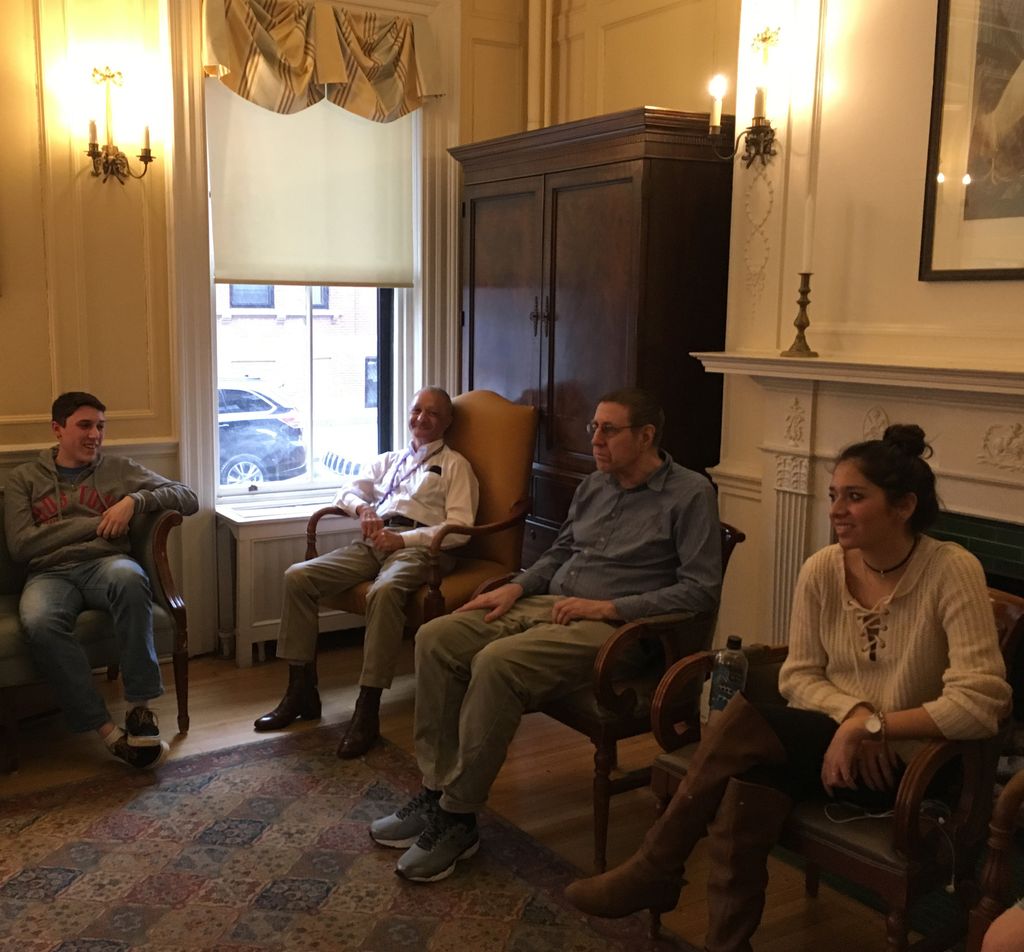Deepening Students’ Connection to the Humanities Through Service Learning
On a snowy day in Boston last winter, a group of Boston University College of General Studies (CGS) students bundled into their winter coats and trekked to Quincy to volunteer for the Prison Book Program, an organization with a simple purpose—sending books to incarcerated people.
In a church basement filled with shelves of books, students searched for books that matched a prisoner’s request, weighed and packaged the books for mailing, and read the organization’s thank you letters from incarcerated people. The students took a tour of United First Parish Church, a national historic landmark that houses the Prison Book Program and also serves as the final resting place for presidents John Adams and John Quincy Adams.
Students said the experience opened their eyes to the importance a book can have in a person’s life—especially when that person doesn’t have access to miles of university library bookshelves and can’t connect to the internet with a smartphone. “I realized the great value of books,” Ie Joo (CGS’18) said in a video the group made. “I realized the value of a book is greater once you don’t have the books.”
In CGS Lecturer of Humanities Sheila Cordner’s classes, service learning is woven into the curriculum as an assignment. Cordner has led a university-wide workshop on service learning, has presented on service learning at the Northeast Modern Language Association Conference, and has developed a faculty guide at the request of the Boston University Center for Teaching and Learning. In the spring 2017 semester, Cordner’s students also led a discussion of Charles Dickens at Hale House, a nonprofit assisted living facility in Boston, and facilitated a discussion of impressionist art at the Boston Public Library’s Adult ESL Conversation Circle.

What separates service-learning projects from volunteerism or community service? Service-learning projects have learning objectives: students will help make arts of work and literature accessible to an audience that may not know them; they will gain a deeper understanding of how that audience responds to this art and literature; and they will gain a more in-depth understanding of the material they have studied in the course.
Self-assessment and reflection are a critical part of the service-learning process. Students create a film or do a group presentation, reporting back to the rest of their class about their experience. Individually, the students write a reflection relating their experience back to the course themes and texts.
It all leads to a richer appreciation of the humanities and a deeper understanding of the texts that students are studying. “I expected to expand my knowledge on literature and that’s exactly what I got,” Alejandra Sanchez (CGS’18) said after visiting the Prison Book Program. Olivia Galarza (CGS’18) noticed that Hale House residents could quote specific lines or talk about Dickens characters they remembered decades after reading the books: “An important message I took away from our trip to the Hale House was just how big of an impact the humanities made in an individuals’ life on a personal level.” David Broderick (CGS’18) said, “I was pleasantly surprised to see that Dickens’s name still holds tremendous weight and importance. Everyone in our discussion was touched by Dickens’s writings in some way.”
In reading students’ reflections and assessing their learning, Cordner has noticed that students’ understanding of the course material is closely linked to their appreciation for the humanities. When students gain a deeper understanding of the value of the humanities, they bring a more nuanced understanding to the texts they’re studying.
The service-learning projects also help students see their own privilege and understand lives that are very different from their own—whether it’s seeing the diverse reading interests of incarcerated people or discussing generational differences with the elderly.
“When I watch the students’ films and read their reflection papers, they remind me how the humanities can bring people of different generations, classes, races, genders, sexualities, and nationalities together,” Cordner says. “Ultimately the projects help students realize the connections between the required humanities general education course and their own lives.”
Vivian Lee (CGS’18) echoed this: “It’s our duty to at least try to figure out what life is like for other people. … I think that with the ability to read words, we then have the responsibility to read books and learn.”
In partnership with the Boston University Center for Teaching and Learning, Sheila Cordner has prepared a guide to service learning. It shares information on the background of service learning, the benefits, and how to structure service learning in a course. She has also coauthored a strategy guide to help Boston University faculty incorporate service learning into their BU Hub general education courses.